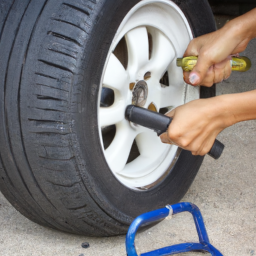Tire maintenance is one of the most important aspects of owning a vehicle. Proper tire maintenance can not only improve the safety and performance of your vehicle, but also increase the lifespan of your tires, resulting in reduced costs and less waste.
One of the most common issues with tires is low pressure. Low tire pressure can cause a number of problems, including decreased fuel efficiency, increased wear on the tires, and an increased risk of a blowout or accident. It’s important to check your tire pressure regularly, at least once a month or before long trips. Most vehicles have a recommended tire pressure listed on a sticker inside the driver’s door or in the owner’s manual. Use a tire pressure gauge to check the pressure and add air as needed.
Another important aspect of tire maintenance is proper alignment. Misaligned tires can cause uneven wear on the tires, which can lead to a decrease in handling and stability, as well as reduced fuel efficiency. Signs of misalignment include a vehicle that pulls to one side or unusual tire wear patterns. If you notice these signs, take your vehicle to a mechanic to have the alignment checked and adjusted as needed.
Balancing your tires is also important for proper tire maintenance. Balancing ensures that the weight of the tire and wheel assembly is evenly distributed, which can help prevent vibration and improve handling. You may notice signs of an unbalanced tire, such as vibrations at certain speeds or uneven wear on the tires. Have your tires balanced regularly, at least once a year or whenever you have new tires installed.
Regular tire rotations are another important aspect of tire maintenance. Rotating your tires can help ensure that they wear evenly, which can improve handling and allow you to get the maximum lifespan out of your tires. Most manufacturers recommend rotating your tires every 5,000 to 7,500 miles, but check your vehicle’s owner’s manual for specific recommendations.
Finally, it’s important to inspect your tires regularly for signs of damage or wear. Look for cuts, punctures, or bulges in the sidewall, and check the tread depth using a penny or a tire depth gauge. If the tread is worn down to 2/32 of an inch or less, it’s time to replace the tire. Additionally, if you notice any unusual vibrations, noises, or handling issues, have your tires inspected by a professional.
In conclusion, proper tire maintenance is essential for the safety and performance of your vehicle. By checking your tire pressure regularly, ensuring proper alignment and balancing, rotating your tires, and inspecting for signs of damage or wear, you can improve the lifespan of your tires and reduce costs in the long run. Make tire maintenance a priority to keep yourself and your vehicle safe on the road.

